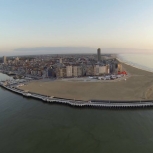
Ostend
Ostend is a city on the Belgian coast which is known for its long beach and promenade. Ostend is centrally located along the coast, 35 km from the Dutch border and 30 km from the French border. Cities such as Amsterdam, Brussels, Cologne, London, Luxembourg, Paris, Lille and Rotterdam are within a 300 km radius.
The city is on the verge of transformation to become a more resilient, smart and sustainable future proof city. A lot of the current ongoing initiatives and future plans are related to this strategy. The City of Ostend is a leader in Flanders in the field of sustainable and renewable energy.The port of Ostend was once Belgium’s largest passenger harbour, but this activity has reduced sharply in recent years. A major part of the traffic consists of sand and gravel dredged from the sea for the local building industry. The port also plays an active part in Belgium’s energy transition. It serves as a base for offshore wind parks and calls itself the country’s “energy port”. The municipality is investigating ways of spatially facilitating this role. The Port of Ostend (AGHO), which commercially operates the seaport, has invested heavily in renewable energy in recent years. The port was adapted and expanded as a hub for the offshore industry. In this context, the Port of Ostend opted for a clear strategy option to profile itself as a service port and host for several departments of the Flemish Government. The development of the offshore cluster is very important. By the end of 2017, 460 jobs had already been created, while the outer harbour offered work to just over 1,350 people. In the inland port, the focus is on the transhipment of bulk goods, in which a number of niche activities were recently attracted. New industries are also being attracted to the inner harbour, such as chemicals, circular economy and bio-energy. At the end of 2017, a new shipping company announced its intention to operate a cargo ferry connection between Ostend and Ramsgate using 3 ships (12 crossings). The ferry connection is expected to start in May/June 2018.
As far as Tourism is concerned, 2016 estimates indicate the city benefitted from 1,254,283 overnight stays and 3.5m day visitors. The House of Economy, the Ostend Port, Ostend City and the public employment service of Flanders are the driving forces behind an intensive employment plan for the Ostend region. The aim is to fill vacancies on the labour market quickly and efficiently through very concrete projects. The job marketeers on the one hand ensure better contact between companies and job-seekers. On the other hand, job-seekers are encouraged to re-orientate themselves on the labour market.
SOME RELATED NETWORKS
BluAct
Article



